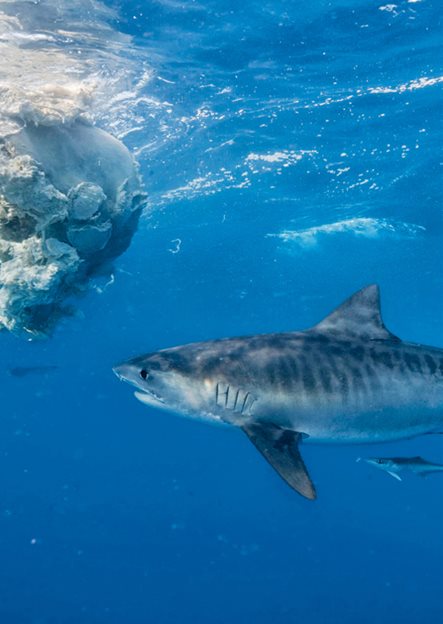All rights reserved. Reproduction of the whole or any part of the contents without written permission from the publisher is prohibited.
Since 1888, the National Geographic Society has funded more than 12,000 research, exploration, and preservation projects around the world. The Society receives funds from National Geographic Partners, LLC, funded in part by your purchase. A portion of the proceeds from this book supports this vital work. To learn more, visit www.natgeo.com/info.
For more information, please visit www.nationalgeographic.com, call 1-800-647-5463, or write to the following address:
For rights or permissions inquiries, please contact National Geographic Books Subsidiary Rights:
NATIONAL GEOGRAPHIC and Yellow Border Design are trademarks of the National Geographic Society, used under license.

Photographer David Doubilet comes face-to-face with some Caribbean reef sharks. ()

A tiger shark feeds on a dead sperm whale. ()
T he radio on the boat crackled to life. David Doubilet and his wife and diving partner, Jennifer Hayes, listened closely. A dead sperm whale had been sighted off the reef of Cairns in Australia. This was rare. There had not been a sperm whale carcass sighting in 30 years. Ten large tiger sharks were feeding on the whale. David knew they had to photograph it.
Its unusual to see sharks feeding in the wild. Sometimes sharks are hand-fed during tours so tourists can dive and see them. David and Jennifer knew that this natural feeding would be a special opportunity.
They set the boats coordinates (sounds like co-ORE-din-its) to where the whale had been spotted, and sped along the water as fast as they could. Yet when they arrived at their destination, there was no whale to be seen. The wind and tide had moved it, but where?
David and Jennifer scanned the water. Finally, they saw a large mass floating on the oceans surface. They breathed a sigh of relief. It was the whale.
The whales white flesh was oozing whale oil. The strong smell filled the air. And eight large tiger sharks circled the carcass. It was time for David and Jennifer to get a closer look.
David and Jennifer slipped into the water. From there, they had a much better view. The sharks teeth ripped into the whales body, tearing it to shreds. David and Jennifer raised their cameras and began taking pictures.
Did You Know?
Sharks are ancient animals. The first one lived on Earth about 400450 million years ago.
They knew that as long as they kept their distance from the sharks, theyd be safe. After all, the sharks were busy eating the whale. But they had taken some precautions (sounds like pree-COSH-ens), just in case. Both were wearing full diving gear. We always wear full wet suits, including gloves that cover our hands, said Jennifer. Our bare hands look a lot like dead fish and may be tempting to a shark used to seeing dead fish as food. They also had their cameras. In some ways, those big cameras helped the team feel safer. It was like having an extra layer of protection between them and the sharks.
So, David and Jennifer focused on shooting pictures. The sharks focused on their meal. In fact, the sharks didnt seem to notice David and Jennifer at all.
But as they kept taking pictures, David and Jennifer didnt realize they were getting closer and closer to the tiger sharks and their carcass. The sharks noticed, though. Suddenly, the mood changed. The sharks were interested in the two humans bobbing in the water.
David and Jennifer looked around. They had somehow drifted too close to the whale. Now, the sharks saw them as a threat. Finding food in the ocean can be hard, and sharks will protect their meal. David and Jennifer werent safe anymore.
The sharks began to circle. They swam close enough to bump into David and Jennifer. Thats when the photographers thought about their extra layer of protection. They held their cameras in front of them to block the sharks.
Suddenly, one of the sharks lunged forward. It bit at one of the large, round strobe lights attached to the cameras. Other sharks did the same.

()
David and Jennifer are married, and they work together, too! On land, they have different jobs. David prepares their camera gear and lights. Jennifer researches their subjects and talks with experts. Underwater, they work as a team. To make sure they understand each other underwater, they use hand signals. Or they write using a dive slate and pencil. In dangerous situations, David and Jennifer wear face masks with voice gear so they can talk to each otherthats the clearest form of communication.
Strobes are normally used to light up dark areas. But now they were being used as shark shields!
David and Jennifer needed a way to fend off the sharks until they could swim to safety. They changed their position in the water and put their backs against each other. This way they could see all around them. They could see where the sharks were. That would keep them safe.
They began to swim slowly away from the sharks and toward their boat. The key was to keep their movements small. If they moved too quickly, the sharks would react.
Soon, they put space between themselves and the sharks. That seemed to work. No longer thinking someone was after their food, the sharks headed back toward the whale to finish their meal.
The danger had passed. David and Jennifer shook off the scary encounter. They raised their cameras again to take more photos.
The sun was beginning to set. Dawn and dusk are prime feeding times for sharks. The water was full of the smell of whale oil. That smell brought more tiger sharks to the whale.
David and Jennifer were still in the water taking pictures. But they and their gear were now covered in whale oil.










